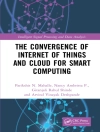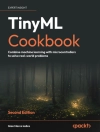Ultra-Reliable and Low-Latency Communications (URLLC) Theory and Practice
Comprehensive resource presenting important recent advances in wireless communications for URLLC services, including device-to-device communication, multi-connectivity, and more
Ultra-Reliable and Low-Latency Communications (URLLC) Theory and Practice discusses the typical scenarios, possible solutions, and state-of-the-art techniques that enable URLLC in different perspectives from the physical layer to higher-level approaches, aiming to tackle URLLC’s challenges with both theoretical and practical approaches, which bridges the lacuna between theory and practice.
With long-term contributions to the development of future wireless networks, the text systematically presents a thorough study of the novel and innovative paradigm of URLLC; basic requirements are covered, along with essential definitions, state-of-the-art technologies, and promising research directions of URLLC. To aid in reader comprehension, tables, figures, design schematics, and examples are provided to illustrate abstract engineering concepts and make the text more accessible to a broader readership, and corresponding case studies are included in the last part of the book.
Fundamental problems in URLLC, including designing building blocks for URLLC, radio resource management in URLLC, resource optimization, network availability guarantee, and coexisting with other future mobile networks, are also discussed.
In Ultra-Reliable and Low-Latency Communications (URLLC) Theory and Practice, readers can expect to find detailed information on:
* BCH and analog codes, stable matching, OFDM demodulation and turbo coding, and semi-blind receivers for URLLC
* MIMO-NOMA with URLLC, PHY and MAC layer technologies for URLLC, and Network slicing or SDN for URLLC and e MBB
* Integrating theoretical knowledge into deep learning for URLLC, Energy-Latency tradeoff in URLLC, and Downlink transmission for URLLC under physical layer aspects
* Resource allocation for multi-user downlink URLLC, HARQ optimization for 5G URLLC, and Multi-Access edge computing with URLLC
A unique resource with comprehensive yet accessible coverage of a complicated subject, Ultra-Reliable and Low-Latency Communications (URLLC) Theory and Practice is an ideal resource for a large and diverse population of researchers and practitioners in engineering, computer scientists, and senior undergraduate and graduate students in related programs of study.
Inhaltsverzeichnis
Preface vii
List of Contributors ix
1 URLLC: Faster, Higher, Stronger, and Together 1
Changyang She, Trung Q. Duong, Saeed R. Khosravirad, Petar Popovski, Mehdi Bennis, and Tony Q.S. Quek
2 Statistical Characterization of URLLC: Frequentist and Bayesian Approaches 15
Tobias Kallehauge, Pablo Ramirez-Espinosa, Anders E. Kalør, and Petar Popovski
3 Characterizing and Taming the Tail in URLLC 61
Chen-Feng Liu, Yung-Lin Hsu, Mehdi Bennis, and Hung-Yu Wei
4 Unsupervised Deep Learning for Optimizing Wireless Systems with Instantaneous and Statistic Constraints 85
Chengjian Sun, Changyang She, and Chenyang Yang
5 Channel Coding and Decoding Schemes for URLLC 119
Chentao Yue, Mahyar Shirvanimoghaddam, Branka Vucetic, and Yonghui li
6 Sparse Vector Coding for Ultra-reliable and Low-latency Communications 169
Byonghyo Shim
7 Network Slicing for URLLC 215
Peng Yang, Xing Xi, Tony Q. S. Quek, Jingxuan Chen, Xianbin Cao, and Dapeng Wu
8 Beamforming Design for Multi-user Downlink OFDMA-URLLC Systems 241
Walid R. Ghanem, Vahid Jamali, Yan Sun, and Robert Schober
9 A Full-Duplex Relay System for URLLC with Adaptive Self-Interference Processing 259
Hanjun Duan, Yufei Jiang, Xu Zhu, and Fu-Chun Zheng
10 Mobility Prediction for Reducing End-to-End Delay in URLLC 291
Zhanwei Hou, Changyang She, Yonghui Li, and Branka Vucetic
11 Relay Robot-Aided URLLC in 5G Factory Automation with Industrial Io Ts 321
Dang Van Huynh, Saeed R. Khosravirad, Yuexing Peng, Antonino Masaracchia, and Trung Q. Duong
Index 343
Über den Autor
Trung Q. Duong is a Chair Professor of Telecommunications, School of Electronics, Electrical Engineering and Computer Science at Queen’s University Belfast, UK and a Research Chair of Royal Academy of Engineering. He is a Fellow of the IEEE.
Saeed R. Khosravirad is a Member of Technical Staff at Nokia Bell Labs, Murray Hill, NJ, USA. He is currently leading research projects in Bell Labs investigating various aspects of radio access for industrial Io T.
Changyang She is a Research Associate with The University of Sydney, Australia. He is serving as the Australian Research Council, Discovery Early Career Researcher Award (DECRA) Fellow at the University of Sydney.
Petar Popovski is a Professor at Aalborg University, Denmark. He is Villum Investigator, previous holder of a Consolidator Grant (2015-2020) from the European Research Council (ERC) and a recipient of the Danish Elite Researcher Award (2016). He is a Fellow of the IEEE.
Mehdi Bennis is a Full Professor at the Centre for Wireless Communications, University of Oulu, Finland. Dr Bennis is a Specialty Chief Editor for Data Science for Communications in the Frontiers in Communications and Networks journal. He is a Fellow of the IEEE.
Tony Q.S. Quek is a Full Professor at Singapore University of Technology and Design (SUTD). He is also the Director of Future Communications R&D Programme, ISTD Pillar Head, Sector Lead of SUTD AI Program, and Deputy Director of the SUTD-ZJU IDEA. He is a Fellow of the IEEE.












